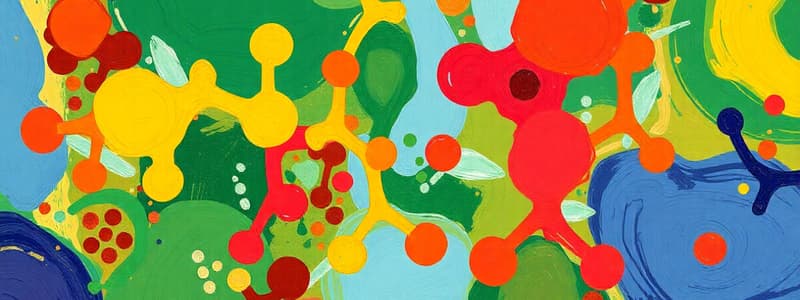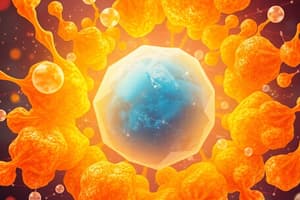Podcast
Questions and Answers
During anaerobic glycolysis, what is the net production of ATP molecules per molecule of glucose?
During anaerobic glycolysis, what is the net production of ATP molecules per molecule of glucose?
- 4 ATP
- 3 ATP
- 36 ATP
- 2 ATP (correct)
What is the primary fate of pyruvate under anaerobic conditions in mammalian cells?
What is the primary fate of pyruvate under anaerobic conditions in mammalian cells?
- Transamination to alanine
- Carboxylation to oxaloacetate
- Oxidation to acetyl-CoA
- Reduction to lactate (correct)
If a muscle cell relies solely on anaerobic glycolysis during intense exercise, which of the following metabolic by-products would accumulate?
If a muscle cell relies solely on anaerobic glycolysis during intense exercise, which of the following metabolic by-products would accumulate?
- Lactate (correct)
- Oxaloacetate
- Citrate
- Alpha-ketoglutarate
Which enzymatic reaction is bypassed during the anaerobic regeneration of $NAD^+$ from $NADH$?
Which enzymatic reaction is bypassed during the anaerobic regeneration of $NAD^+$ from $NADH$?
How does a high concentration of glucose-6-phosphate affect hexokinase activity in most cells?
How does a high concentration of glucose-6-phosphate affect hexokinase activity in most cells?
Flashcards
Anaerobic Metabolism
Anaerobic Metabolism
Metabolic process that breaks down glucose without oxygen.
Glycolysis
Glycolysis
The breakdown of glucose to produce ATP and pyruvate, without oxygen.
Two Phases of Anaerobic Glycolysis
Two Phases of Anaerobic Glycolysis
Energy investment and energy payoff.
Net Products of Anaerobic Glycolysis
Net Products of Anaerobic Glycolysis
Signup and view all the flashcards
Hexokinase and Glucokinase
Hexokinase and Glucokinase
Signup and view all the flashcards
Study Notes
- Anaerobic metabolism involves glycolysis.
Carbohydrates
- Monosaccharides have the chemical formula C6H12O6.
- Examples of monosaccharides are glucose, fructose, and galactose.
- Disaccharides are composed of 2 monosaccharides.
- Disaccharides are broken down into monosaccharides in the gastrointestinal tract.
- Lactose is a disaccharide made of galactose and glucose, and it is broken down by lactase.
- Sucrose is a disaccharide containing fructose and glucose, and it is broken down by sucrase.
Complex Carbohydrates
- Polysaccharides are polymers of monosaccharides.
- Starch is a plant polysaccharide made of glucose polymers.
- Glycogen is an animal polysaccharide containing glucose polymers.
- Cellulose is a plant polysaccharide comprised of glucose molecules with different bonds from starch.
- Animals cannot break down cellulose.
- Cellulose acts as "fiber" in the diet, improving bowel function.
- All carbohydrates are broken down into glucose, fructose, and galactose.
Glucose Metabolism
- Glucose can be used for anaerobic metabolism, the TCA cycle, the HMP shunt, fatty acid synthesis, and glycogenesis.
- Anaerobic metabolism produces lactate.
- The TCA cycle produces H2O and CO2.
- The HMP shunt produces ribose/NADPH.
- Fatty acid synthesis produces fatty acids.
- Glycogenesis produces glycogen.
Glucose Metabolism in Different Tissues
- The liver has the most varied use of glucose and uses the TCA cycle for ATP and glycogen synthesis.
- The brain constantly uses glucose for the TCA cycle to produce ATP and has little glycogen storage.
- Muscle and heart tissues use the TCA cycle and transport glucose into cells, which is heavily influenced by insulin with more insulin leading to more glucose uptake.
- Muscle and heart tissues store glucose as glycogen.
- Red blood cells lack mitochondria and use glucose for anaerobic metabolism to make ATP and generate lactate.
- Red blood cells also use glucose for the HMP shunt (NADPH).
- Adipose tissue mostly converts glucose to fatty acids, with glucose uptake influenced by insulin, similar to muscle tissue.
Glycolysis
- Glycolysis involves converting glucose to glucose-6-phosphate, fructose-6-phosphate, fructose-1,6-bisphosphate, glyceraldehyde-3-phosphate, dihydroxyacetone phosphate, 1,3-bisphosphoglycerate, 3-phosphoglycerate, 2-phosphoglycerate, phosphoenolpyruvate, and finally pyruvate.
Glucose Transport into Cells
- Glucose enters cells through glucose transporters.
- There are two types of glucose entry into cells: Na+ independent and Na+ dependent.
- In Na+ independent entry, there are 14 different transporters, GLUT-1 to GLUT-14, which vary by tissue.
- GLUT-1 is in red blood cells.
- In Na+ dependent entry, glucose is absorbed from low to high concentration.
- Na+ dependent entry occurs happens in the intestinal epithelium and renal tubules.
- Glycolysis is used by all cells of the body.
- Glycolysis occurs as a sequence of reactions in the cytoplasm.
- Glycolysis converts glucose, which has 6 carbons, to pyruvate, which as 3 carbons.
- Glycolysis generates ATP and NADH.
NADH
- NADH is nicotinamide adenine dinucleotide, which consists of two nucleotides and carries electrons.
- NAD+ accepts electrons.
- NADH donates electrons and can donate them to the electron transport chain to produce ATP.
Phases of Anaerobic Glycolysis
- There are two phases of anaerobic glycolysis: energy investment and energy generation.
- In the energy investment phase, 2 ATP are consumed.
- In the energy generation phase, 4 ATP and 2 NADH are produced.
- The net result of anaerobic glycolysis is the production of 2 pyruvate, 2 ATP, and 2 NADH from glucose, 2 ADP, and 2 NAD+.
- The priming stage of glycolysis uses energy and consumes 2 ATP.
- The first and last reactions in glycolysis are the most critical.
- The first step phosphorylation of glucose.
Glucose-6-Phosphate Metabolism
- After phosphorylation, glucose becomes glucose-6-phosphate which can undergo different pathways including glycolysis, glycogen synthesis, and the pentose phosphate pathway.
Hexokinase vs. Glucokinase
- Hexokinase is found in most tissues and is strongly inhibited by glucose-6-phosphate(G6P).
- Hexokinase blocks cells from hoarding glucose and is not affected by insulin.
- Hexokinase has a low Km and Vm.
- Glucokinase is found in the liver and pancreas and is not inhibited by G6P.
- Glucokinase is induced by insulin, which promotes transcription.
- Glucokinase is inhibited by fructose-6-phosphate but can be overcome by high glucose levels.
- Glucokinase has a high Km, and its rate varies with glucose concentration.
- Glucokinase becomes inactive when glucose levels are low, and fructose-6-phosphate levels are high.
- When blood sugar is low: hexokinase is working and not inhibited by G6P, glucokinase is inactive due to low glucose and insulin levels, and glucose goes to tissues other than the liver.
- When blood sugar is high: hexokinase is inactive due to inhibition by G6P, glucokinase is working due to high glucose and insulin levels, and the liver stores glucose as glycogen.
Glucokinase Deficiency
- Glucokinase deficiency results in hyperglycemia.
- In individuals with glucokinase deficiency, the pancreas is less sensitive to glucose resulting in mild hyperglycemia.
- Glucokinase deficiency is often exacerbated by pregnancy.
Isomerization of Glucose-6-Phosphate
- Glucose-6-phosphate (aldose) is isomerized to fructose-6-phosphate (ketose) via phosphoglucose isomerase.
Phosphorylation of Fructose-6-Phosphate
- Fructose-6-phosphate is phosphorylated to fructose-1,6-bisphosphate.
- ATP, citrate, AMP, and fructose 2,6-bisphosphate regulate this process.
Phosphofructokinase-1
- Phosphofructokinase-1 is the rate-limiting step for glycolysis and consumes the 2nd ATP of the priming stage.
- It commits glucose to glycolysis, making HMP shunt and glycogen synthesis no longer possible.
- The reaction is irreversible.
Studying That Suits You
Use AI to generate personalized quizzes and flashcards to suit your learning preferences.




